Table of Contents
Overview – Neurobiology of Emotions
The neurobiology of emotions involves complex responses integrating mental states, physiological changes, and behavioural outputs. They are crucial to survival, cognition, social interaction, and learning. The neurobiology of emotion explores how feelings are generated, modulated, and recognised, including key brain regions like the amygdala and neurotransmitters like serotonin, dopamine, and noradrenaline. This guide outlines the underlying mechanisms and clinical relevance of emotions for final-year medical students.
Definitions
- Affect: Experience of a feeling/emotion unrelated to bodily changes
- Emotion: A mental and physiological response to stimuli (affect + bodily changes)
- Feelings: Subjective responses, partly mental and partly physical
- Arousal: Visceral body response (ANS & neuroendocrine activity)
- Cognition: Awareness and judgement
- Behaviour: Active motor response (posture, expression, speech)
Theories of Emotion
- Why Emotion Exists:
- Vital to survival (danger detection, social bonding)
- Aids in decision-making and memory formation
- James-Lange:
- Visceral response first → Emotion follows
- “I feel afraid because I tremble”
- Cannon-Bard:
- Brain interprets stimulus → Simultaneous emotional and physiological response
- “The bear makes me tremble and feel afraid”
- Current View:
- Physiological reaction precedes emotional experience
- Emotional experience can reinforce or prolong physiological state
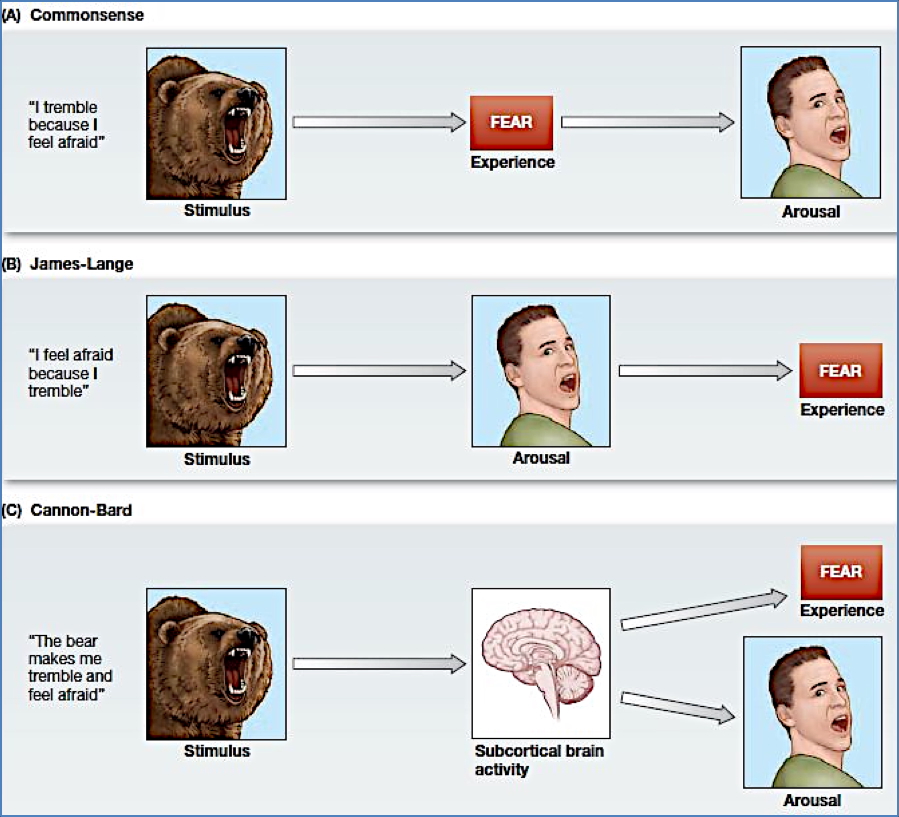

Types of Emotions
1. Primary Emotions
- First, primitive, instinctual
- Universal across cultures
- E.g.: Joy, sadness, fear, anger, surprise
2. Secondary Emotions
- Arise from primary emotions + context
- More complex
- E.g.: Affection, love, guilt, disgust, envy
3. Tertiary Emotions
- Highly complex, often decision-based
- E.g.: Satisfaction, frustration, hope, contempt

Consciousness and Emotion
- Emotional experience is thought to underpin consciousness
- Core consciousness: “here and now” sensory and emotional experience
- Extended consciousness: integrates past experiences to influence learning and planning
- Alexithymia (emotional blindness):
- Difficulty linking stimuli to internal emotional states
- Impaired decision-making and imagination
- Emotionally detached demeanour
Rational vs Emotional Brain
- Higher cognition relies on balance between:
- Rational brain – logical, analytic processing
- Emotional brain – instinctive, context-driven responses
- Anatomically, the emotional brain (limbic structures) is more synaptically dense
- Contextual dominance: e.g., triage scenarios challenge the balance of emotion and reason

Brain Regions Involved in Emotion
- Thalamus: Routes sensory info to amygdala, cortex, and cingulate cortex
- Cingulate Gyrus: Attention regulation, emotional “colouring
- Ventromedial Prefrontal Cortex: Conscious emotion recognition
- Hemispheric Lateralisation:
- Left hemisphere → positive emotions
- Right hemisphere → negative emotions
- Insula: Recognition of disgust
- Sensory cortices/association areas: Process and identify stimuli
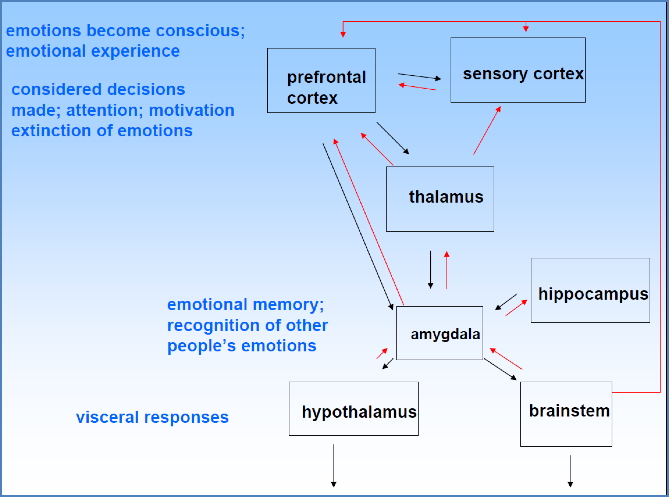
The Papez Circuit
- Thalamus → Cingulate Cortex (emotional experience)
- Cingulate Cortex → Neocortex (contextual colour), → Hippocampus
- Hippocampus → Hypothalamus (emotional expression)
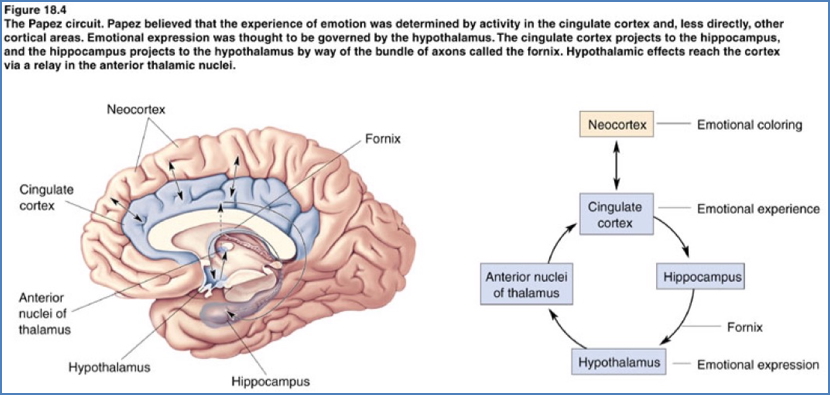
The Limbic System & Amygdala
- Amygdala: Central hub for emotional processing
- Inputs from: brainstem, hypothalamus, thalamus, hippocampus, cortex
- Outputs to: brainstem (visceral responses), hypothalamus, thalamus, hippocampus, prefrontal cortex
- Regulates:
- Fear, aggression
- Vigilance, attention
- Emotional memory and recognition
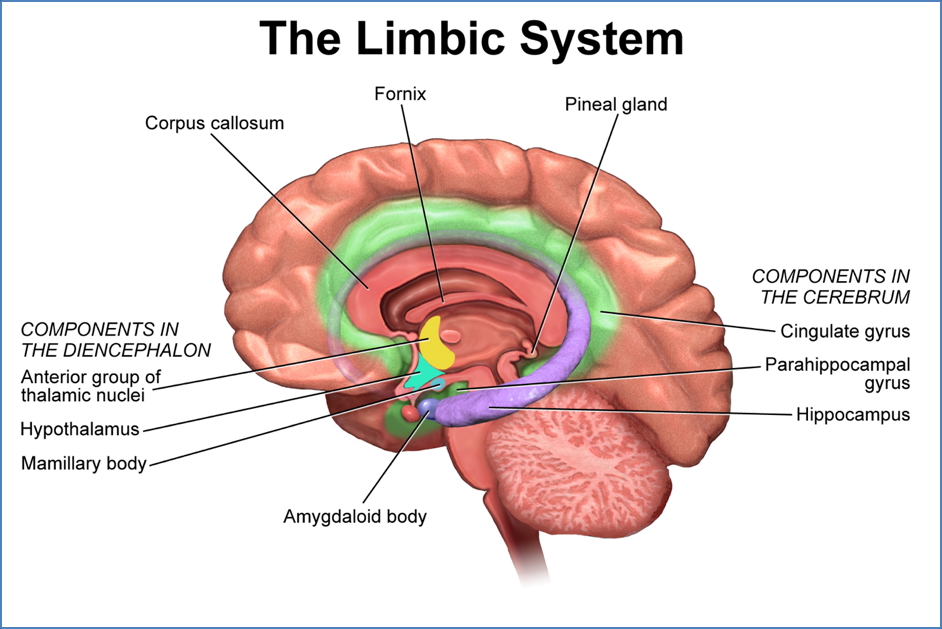
Hypothalamus & Brainstem
- Hypothalamus: Drives visceral responses, aggression, libido
- Brainstem: Mediates autonomic emotional responses
Neurotransmitters Involved in Emotion
Noradrenaline (Locus Coeruleus)
- Novel stimuli → arousal, anxiety, mood, pain, sleep-wake
Serotonin (Raphe Nuclei)
- Regulates emotion, aggression, anxiety, mood, arousal
Dopamine (VTA, Substantia Nigra)
- Reward perception, pleasure, emotion regulation
Glutamate & GABA
- Balance of excitation/inhibition → modulates anxiety
Acetylcholine (Nuclei of Meynert)
- Cognitive processing, attention, arousal
The Emotion of Fear
Brain Pathways:
- Stimulus → Thalamus → Amygdala
- Thalamus also relays to sensory and association cortices
Dual-Pathway Processing:
- Short route: Direct to amygdala → rapid, crude response (freeze/startle)
- Long route: Via cortex → refined, slower interpretation
- Outcome: Amygdala activates hypothalamus (visceral) and prefrontal cortex (conscious emotion)
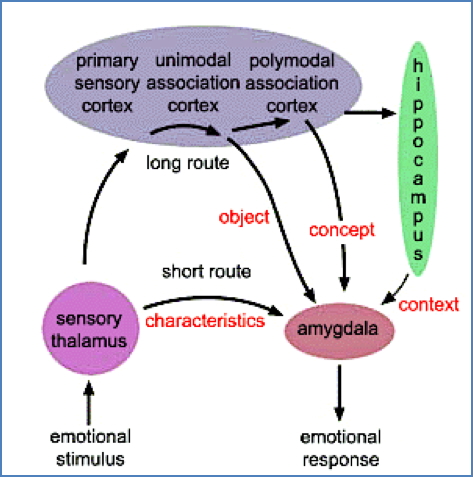
Aggression
- Types:
- Affective aggression: Emotional, high autonomic output
- Predatory aggression: Quiet, purposeful, no sympathetic arousal
- Structures involved:
- Amygdala, hypothalamus, cerebral cortex, PAG, VTA
- Key Neurotransmitter: Serotonin
- Possible hormonal influence: Adenosine
Pleasure & Reward
- Structures:
- Ventral Tegmental Area (VTA)
- Nucleus Accumbens
- Amygdala
- Prefrontal Cortex
- Thalamus
- Key NT: Dopamine
- VTA → Nucleus Accumbens → Reward perception
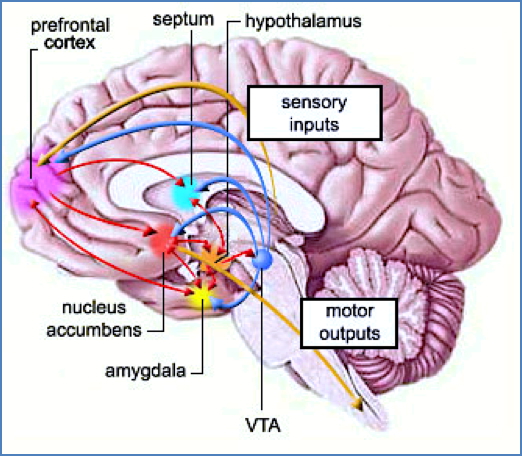
Summary – Neurobiology of Emotions
Emotions are multifaceted processes driven by both brain and body. The limbic system, especially the amygdala, coordinates sensory input, memory, and autonomic responses to generate affective states. Neurotransmitters like dopamine and serotonin fine-tune emotional tone and behaviour. The emotional brain is key in decision-making, survival, and mental health. For a broader context, see our Nervous System Overview page.